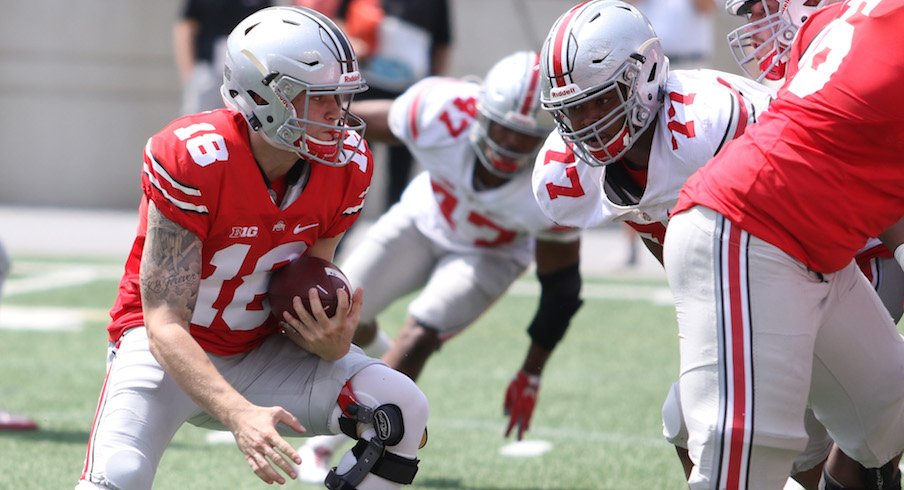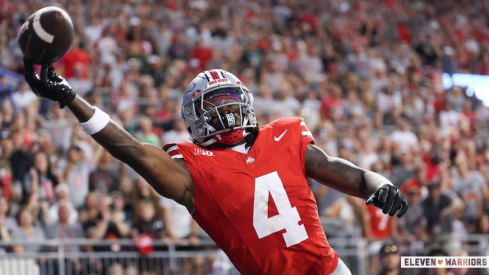Regardless of if he wins the starting quarterback spot, it seems Tate Martell will see the field this upcoming season.
Last week, the redshirt freshman said that "it's already been confirmed" that there will be special packages to get him involved with the offense even if he does not earn the starting quarterback job this offseason.
Naturally, this generated quite the buzz and had Buckeye fans wondering why the team would elect to do this. The short answer is that there are definite advantages to having a dual-threat quarterback, and Martell is certainly the best runner of the group. Martell could be a useful asset in the offense, particularly if the less-mobile Dwayne Haskins wins the starting job.
Tate Martell would provide the Buckeyes with a change-of-pace wildcat package that Opposing Defenses still have to respect through the air.
A designed quarterback run gives the offense an inherent numbers advantage compared to a handoff to a running back. This is because the offense gains a blocker on the play since it's a direct snap to the ballcarrier with 10 blockers ahead as opposed to a handoff, where the quarterback is essentially out of the play after giving the ball off to the running back, leaving nine blockers for 11 defenders.
Quarterback keepers are especially effective in short yardage situations, because it makes many, if not all of the blocking battles in the trenches one-on-one. This means the play's success rests primarily on individual execution up front, even if the defense has a good idea of what's coming – good news if you feel you have the personnel advantage in the trenches.
However, not every quarterback is a threatening runner – but every team has running backs. Many teams regularly use this same concept with a running back taking the direct snap instead of the quarterback – the wildcat formation. It uses the same fundamental numbers advantage while getting the ball into the hands of the team's top rusher.
This is undoubtably a tempting thought for Buckeye fans. With two former 1,000-yard rushers on the roster in J.K. Dobbins and Mike Weber, why wouldn't you give them those snaps instead of Martell?
The primary issue with the wildcat formation is there is usually little to no threat of a pass. The defense can safely load up to stop the run without worrying too much about getting beat over the top. With a quarterback back there, there's at least a chance of a pass that the defense has to respect – as much as you know exactly what play is coming.
That's where Martell comes in, as he would provide the Buckeyes with a change-of-pace wildcat package that opposing defenses still have to respect through the air.
Martell is a playmaker with both his legs and his arm. His senior season at Bishop Gorman High School, Martell passed for 2,362 yards and 41 touchdowns – throwing just one interception on 215 attempts. He also rushed for 1,257 yards and 21 touchdowns, rushing for 100 yards five times in 15 games.
Teammates and coaches have been raving about his athleticism and playmaking ability since he arrived on campus and a quick glance at his high school highlights or his spring game performance would show you why the coaches are anxious to get him on the field, even if he isn't the starting quarterback.
Many Ohio State fans are wary of two quarterback systems and wildcat packages after witnessing their role in an underachieving offense during the 2015 season. Buckeye fans watched Braxton Miller take predictable direct snaps that became increasingly ineffective and witnessed a two-quarterback system dissolve after just two games.
The fear is justifiable, but this wouldn't be the same thing as what happened in 2015. For starters, while Martell is an extremely legitimate passing threat, Miller was physically unable throw, and opposing defenses gradually realized that, treating him no differently than they would a running back taking a direct snap.
As far as J.T. Barrett and Cardale Jones' two-quarterback system, that wasn't exactly planned, but an attempt to fix – or at least patch – a seemingly broken and underachieving offense. Ohio State's current offense is not broken – the coaches are just looking for ways to make it as dangerous as possible and utilize their top playmakers.
The best comparison to a former Urban Meyer offense might be how he utilized Tim Tebow during Florida's 2006 national championship season with Chris Leak as the starter. Though that's even a bit of a stretch as Tebow was much bigger than Martell is now and was much more of a downhill, power runner.
If Martell really does see the field as part of special packages this season, expect it to be just that – special packages. It's unlikely to make up a terribly substantial portion of the offense and the coaching staff is unlikely to stick with it if it doesn't appear to be working. Still, it could yield some positive, and exciting results.
There will certainly be fans that think this is all just a gimmick to keep him from transferring and there's no guarantee a special package for Martell would even be effective, or that the team will use it long term in meaningful scenarios. But from a schematic standpoint, there is a legitimate reason to give it a shot.
Of course, Martell could also just put this all to rest by simply winning the starting quarterback job this offseason.


